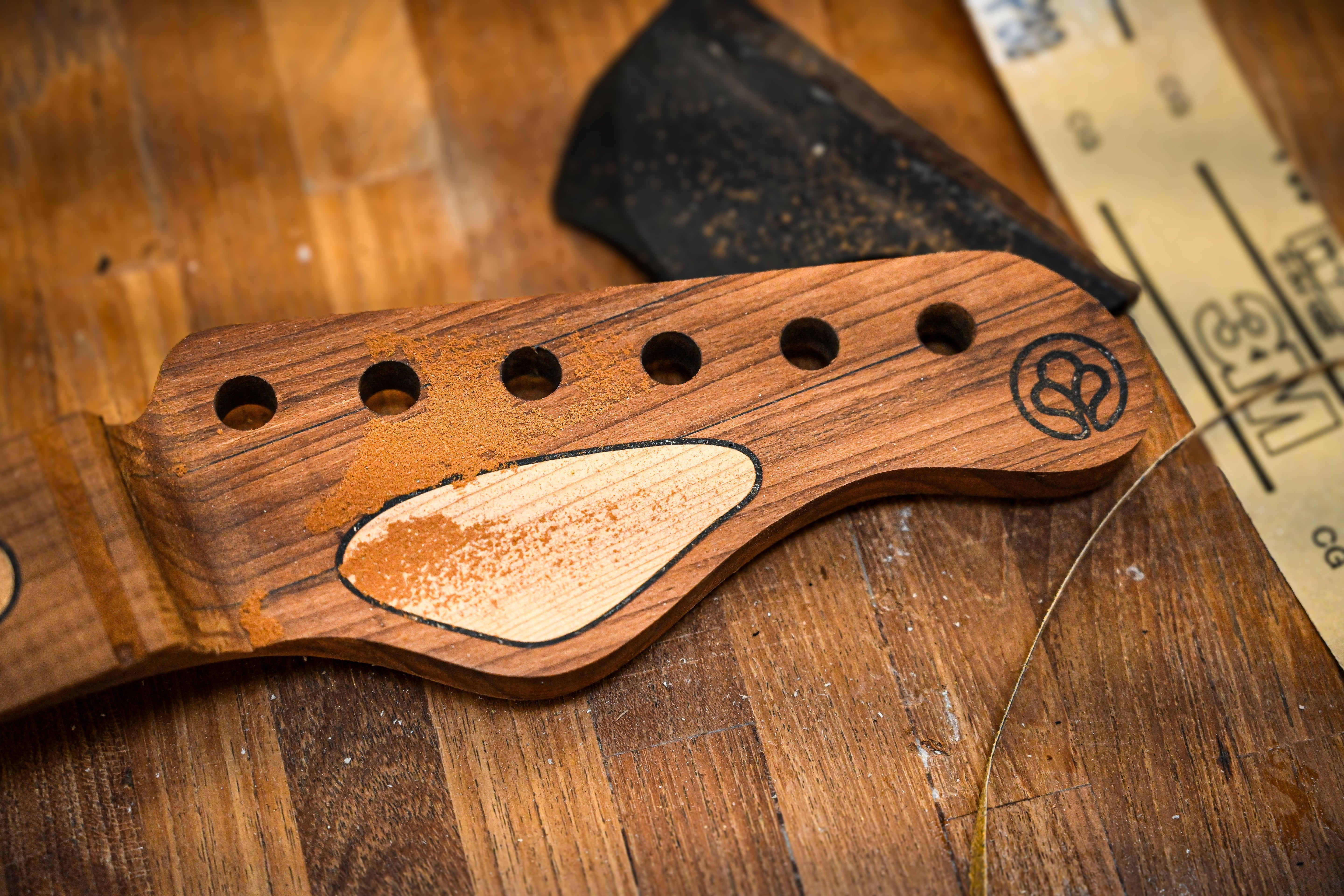あなたのために作られたギターを演奏することには、他に類を見ない力があります。あなたのことを念頭に置いているだけでなく、あなたの手、あなたのスタイル、そしてあなたのサウンドが細部に至るまで形作られています。大量生産された楽器で飽和した世界で、カスタムにすることは、職人技と芸術的な個性のルーツに戻ることを意味します。
しかし、オーダーメイドのワークショップにギターを注文するとき、具体的に何をカスタマイズできるのでしょうか?もし疑問に思ったことがあるなら、このガイドは包括的でありながらアクセスしやすい出発点となります。経験豊富なプレイヤーでも、単に興味があるだけでも、主要なカスタマイズのポイントをすべて見ていきましょう。そして、Belfortiのコンフィギュレーターのような最新のツールが、迷うことなくこれらのオプションを探索するのにどのように役立つかをご紹介します。
1. トーンウッド:サウンドとフィーリングの基礎
木材は単に美的なものではありません。ギターのコアとなるレゾナンス、重量、触覚的なレスポンスを定義します。
-
ボディ材:マホガニーは暖かさと深み、スワンプアッシュは明るさと歯切れの良さ、アルダーはバランス、コリーナは独特の中音域をもたらします。それぞれの選択が、あなたのトーンとギターが体に当たる感触を形作ります。
-
トップ材:フィギュアードメイプル、バックアイバール、コア、マートルなどは、明るさに影響を与え、劇的な視覚的な華やかさを与えます。
-
ネック材:メイプルは安定性とパンチがあり、マホガニーは暖かさを加え、ローステッドウッドは湿度に強く、スモーキーなタッチを加えます。
-
指板:伝統的なローズウッドやエボニーから、ジリコテやパウフェロのようなエキゾチックなオプションまで、それぞれが微妙な音色の特徴と、指の下の異なるテクスチャを提供します。
プレミアムビルダーは、音色の目標に応じて、マッチングまたはコントラストのあるネック・スルーとボルトオンのオプションをよく提供します。
2. フィニッシュ:スタイルと保護の両立
フィニッシュはギターの見た目、感触、そして時にはサウンドにも影響を与えます。美しさだけでなく、耐久性や резонансにも重要な役割を果たします。
-
フィニッシュの種類:ヴィンテージな雰囲気と自然な経年変化をもたらすニトロセルロース、耐久性に優れたポリウレタン、自然な感触のオープンポアオイル。
-
カラーの選択:控えめなナチュラルから、色が変わるメタリック、さらには完全なカスタムグラフィックまで。
-
エイジング/レリック:ショールームのような光沢を求めるプレイヤーもいれば、傷の一つ一つに物語を求めるプレイヤーもいます。控えめなレリック、本格的な使い古し感、またはクリーンでモダンなライン—すべてはお客様次第です。
-
サテン vs グロス:視覚的な質感と、ギターを抱えたときの感触の両方に影響します。
カスタムショップでは、手塗りのバースト、複雑なフェード、または историческиに正確なヴィンテージレプリカにも対応しています。
3. ネックの仕様:エルゴノミクスと演奏性
ギターのどの部分よりも、ネックは快適さに影響を与えます。手が置かれる場所であり、体の一部のように感じられるべきです。
-
ネックプロファイル:C、D、U、ソフトV、非対称、またはお客様の手のサイズに合わせてカスタムカーブ。
-
厚さ:高速シュレッディングのための超薄型、または木材に食い込むような演奏をする人のための分厚いタイプ。
-
指板ラディアス:コードを愛する人のためのヴィンテージ7.25インチ、汎用性の高いプレイヤーのためのコンパウンド10〜16インチ、過激なベンドのためのフラット20インチ。
-
スケール長: стандартный(25.5インチ)、ショートスケール(24.75インチ)、バリトン、または人間工学に基づいたチューニングテンションのためのマルチスケール。
-
フレット:ニッケルシルバーまたはステンレススチール、ミディアムジャンボまたはエクストラトール。あなたの演奏スタイルが最適なものを左右します。
カスタムネックには、独自のヒール形状、アクセス向上、バックカーブのトランジションが付属していることがよくあります。
4. エレクトロニクス:あなたの声を形作る
これは、アンプを通したサウンドの心臓部です。エレクトロニクスは、ギターがアンプやレコーディングにどのように伝わるかを定義します。
-
ピックアップ構成:何でもありです。SSS、HSS、HH、HSH、P90、ミニハムバッカー、または完全にユニークなもの。
-
ピックアップの選択:ブティックワインダー、自社製ピックアップ、またはBare Knuckle、Lollar、Lundgren、TV Jonesなどの классика。
-
配線オプション:直列/並列、コイルタップ、ブレンドノブ、位相切り替え、プッシュ/プル、ピエゾシステム。
-
コントロールレイアウト:ボリュームとトーンを好きな場所に、またはあなたのスタイルに合わせたトグルスイッチ。
-
出力ジャック:サイドマウント、トップマウント、ロッキング、ステレオ、または高度なリグ用のTRS。
最高のビルダーはすべてを手作業で配線し、ステージやスタジオでのニーズに合わせたコントロールシステムを設計するために協力します。
5. ハードウェア:機能性とセンス
初心者は見落としがちですが、ハードウェアの選択はギターの感触、チューニングの安定性、バランスを定義します。
-
ブリッジ:ハードテイル、トレモロ、フローティング、ラップアラウンド、またはヘッドレスシステムも選択可能です。
-
チューナー:ロッキング、ビンテージスタイル、段付き高さ、または特殊用途向けのプラネタリータイプがあります。
-
ハードウェア仕上げ:クロム、ブラック、ゴールド、ブラッシュドニッケル、レリック、またはカラーアルマイト処理されたアルミニウムから選択できます。
-
ストラップロック:従来型のボタン式、または一体型セキュリティシステムがあります。
弦の木やノブに至るまで、お客様の美意識と演奏ニーズに合わせてすべてのパーツを選択できます。
6. 美的ディテール:個性を表現するレイヤー
ギターはキャンバスです。カスタムショップでは、一般的なドットインレイにとどまらない表現が可能です。
-
インレイ:ブロック、ドット、台形、オフセット、カスタムロゴ、マザーオブパール、リコンストーン、またはウッドから選択できます。
-
Binding:ネック、ボディ、ヘッドストックの周囲、または全く無し。コントラストを付けるか、合わせるか。
-
ヘッドストック形状:視覚的な特徴を決定づける要素であり、お客様のロゴやイニシャルを入れる場所にもなります。
-
ノブとプレート:木製ノブ、カスタム機械加工された金属、彫刻入りプレートなどがあります。
音を奏でる前から、楽器が視覚的にお客様の物語を語り始める部分です。
7. セットアップと演奏性:お客様の手のために
製作は、お客様の演奏に合わせて最適化されて初めて完了します。
-
弦高:速弾きには低く、ヘビーストロークには高く設定します。
-
弦のゲージ:軽いベンド、またはアグレッシブなダウンチューニングに合わせてセットアップします。
-
チューニングの好み:ドロップD、Cスタンダード、エクステンデッドレンジなど、カスタムビルドはお客様のニーズに適応します。
-
ナット幅と弦間隔:特にフィンガースタイルやハイブリッドピッキングのプレイヤーにとって重要です。
Belfortiのようなショップでは、計画段階ですべての詳細を検討します。これらのオプションの多くは、技術マニュアルを解読しなくても理想的なセットアップを検討できるように設計されたギターコンフィギュレーターを通じて直接アクセスできます。
8. プレビュー
カスタム製作は、かつては終わりのないメールのやり取りと手描きのスケッチが必要でした。今日では、Belfortiのオンラインコンフィギュレーターのようなツールを使用することで、ビルダーと話す前に、オプションを視覚化、組み合わせ、比較することがこれまで以上に簡単になりました。それは人間的なつながりに取って代わるものではありませんが、特に初めての方にとっては、その体験を豊かにします。
木材の選択からインレイのパターンまで、自信を持って創造性を発揮できるようサポートし、真のルシアー製作を定義する質問や会話への扉を開きます。
9. 最終コード
カスタムギターは、完璧さを追求するものではありません。個性なのです。それは単にユニークなものを持つということではなく、意図と配慮をもって作られた、あなたを反映した何かを持つということなのです。
次の夢の楽器を仕様通りに製作する準備ができている場合でも、単に何が可能かを検討している場合でも、覚えておいてください。カスタムで製作する場合、単にパーツを選択するだけではありません。お客様のサウンドと同じくらい個性的な楽器を構成しているのです。
そして時には、最初のステップはコンフィギュレーターを開いてインスピレーションに身を任せることと同じくらい簡単なことです。





シェア:
2025年 ギタートレンド:素材、仕様、スタイル、そしてサウンド
フレット溝。なぜ?